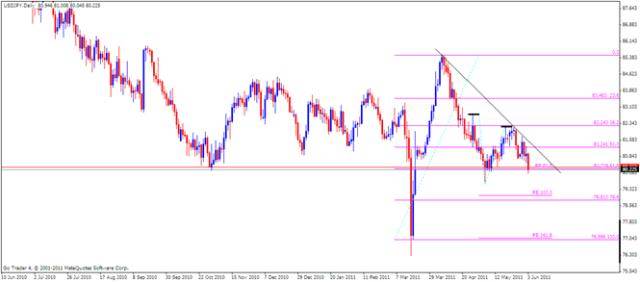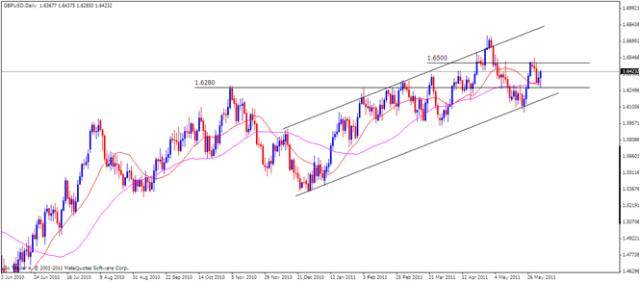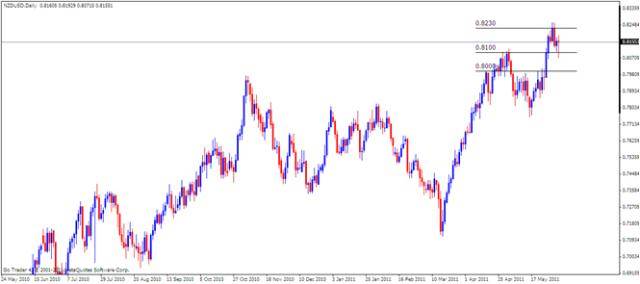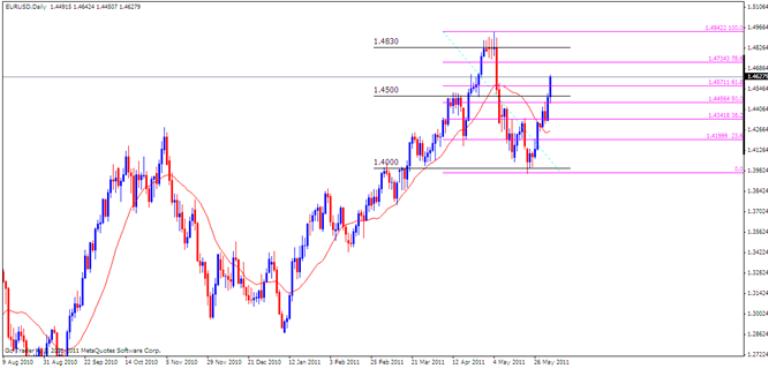USD- Our bias BEARISH, we’ll be looking to sell on rallies
FUNDAMENTALS: Fridays close saw a sharp sell off in the U.S. Dollar after the dreadful Non-Farm Payrolls report undermined the outlook for future U.S. economic growth, with the Greenback likely to face additional selling pressure in the week ahead should the Federal Reserve maintain a cautious outlook for the domestic economy. The dismal jobs number saw a sharp pull back in risk sentiment with the S&P 500 finishing down 2.3%, the Dow down 2.3% and the NASDQ down 2.3%.Credit Suisse Overnight Index Swaps now show the Fed will raise its rate by a paltry 21 basis points in the coming 12 months - less than a third of the 76bps forecast for the European Central Bank. Cross-currency interest rate differentials are likely to continue to haunt the U.S. Dollar at least through the coming 12 months, and wave-after-wave of disappointing economic data will only worsen the Feds outlook, all but guarantying low interest rates. The key question on investors’ minds is whether U.S. economic data will warrant further Fed monetary policy accommodation as its controversial second wave of Quantitative Easing (QE2) expires at the end of this month. U.S. Dollar risks remain to the downside across the board as it seems there are few factors to drive Greenback strength in the week ahead. Low yields continue to punish the Dollar against the highly interest-rate sensitive Japanese Yen, while corrections in the DJIA, S&P 500 and broader market risk have not led to strength in the traditional safe haven U.S. currency. A busy week of interest rate decisions from the Reserve Bank of Australia, Reserve Bank of New Zealand, Bank of England, and European Central Bank represent the greatest foreseeable event risk this week and any surprises for the Australian and New Zealand Dollars, Sterling and Euro may force retracements - yet recent momentum the longer-term outlook favors further U.S.Dollar weakness.
TECHNICALS: Near term support at 72.80, resistance at 75.00. Over the coming week, a test of the falling trend line from early January looks inevitable given the Dollars’ current trajectory, with a daily close below this level exposing the next key support by 70.79. A close above 75.00 and the 50 SMA will be required to relieve downside pressure and as such, we remain bearish the Dollar in the week ahead.
EUR- Our bias BULLISH, we’ll be looking to buy on dips
FUNDAMENTALS: The Euro closed the week some 300 points higher against the U.S. Dollar following Fridays NFP jobs report, Germany backing off its demands for a Greek bond rescheduling, Spain’s successful debt auction, the ECBs’ Jurgen Stark commenting that the central bank was giving consideration to more rate hikes and finally, a positive assessment from the IMF/EU/ECB Troika mission to Athens. The dealer chatter now is that euro zone officials have agreed in principle on a new three year adjustment, including enough funding to keep Greece solvent through to mid-2014. However, realistic market analysts have few illusions that the efforts of the Europeans are only putting off the doomsday scenario by kicking the can down the road once again. While the headlines about financial health and the flawed mathematics of a clean recovery burden the risk aspect of the Euro, we are likely to see the reward side of the currency spotlighted by rate speculation surrounding the ECB’s policy meeting on Thursday. Markets expect the outcome to be no change to the benchmark rate or support facilities but with this meeting, we will also see growth and inflation forecasts updated from March. These figures along with President Trichet’s commentary will guide speculation as to when the next rate hike will be, with considerable discussion doing the rounds of a hike possibly scheduled for July.
TECHNICALS: Near term support at 1.4500, resistance 1.4830. Fridays close above the 61.8% Fib retracement of the 4th - 23rd May decline and the January 2010 high at 1.4579 is significant, opening the door for a test of the 2011 highs by 1.4940. A daily close below 1.4300 is required to relieve the bullish momentum and in view of Thursdays ECB policy meeting, we remain Euro bullish in the week ahead, albeit, pending a clearer picture on risk sentiment.
Japanese Yen. Our bias NEUTRAL, on the sidelines till a clearer picture develops.

JPY- Our bias NEUTRAL, on the sidelines till a clearer picture develops.
FUNDAMENTALS: The Japanese Yen finished 0.64% higher against the U.S. Dollar at the close of trading on Friday as player’s dumped the Greenback on concerns that the economic recovery in the U.S. may be faltering. The Yen was weaker at the start of trade this month after a disappointing industrial production report showed a year on year contraction of 14%, missing consensus estimates that called for a loss of 12.4% y/y. However stronger reads on housing starts and capital spending coupled with safe haven flows sparked by a string of weak U.S. economic data saw a strengthening Yen, with USDJPY breaking below key 80.70 support following Fridays NFP report. The Yen also benefited from ongoing concerns over the US deficit last week after Moody’s cited that it would put the current AAA rating on review if policy makers were unable to come to a consensus on the nations mounting debt. Event risk for the Yen mounts this week with the current account figures on Tuesday followed by the 1Q GDP print on Wednesday. With the Japan back into recession after the devastating March earthquakes, markets will be closely eying the data for a better gauge of the real impact of the natural disaster. Consensus estimates call for an annualized print of -3.1%, an improvement on the previous read of -3.7%, while the quarter on quarter print is expected to come in at -0.8%, from -0.9% q/q. A weaker than expected read on the data could shy investors away from the Yen on concerns regarding the strength of the domestic economy. However, it’s worth noting that a move below 80.00 sees an increased likelihood of intervention from the Bank of Japan as a stronger yen will weigh on exports and with the Japanese economy on shaky ground, the BoJ may move on the Yen at much earlier levels than anticipated.
TECHNICALS: Near term support at 80.00, resistance 81.20. USDJPY touched near one month lows just shy of the key 80.00 handle on Friday which coincides with the 61.8% Fib extension taken from the April and May highs and the 61.8% Fib retracement of the 17th March - 6th April rally. A break below this key level eyes targets lower at 79.00, the 100.0% Fib extension and further down the 161.8% Fib extension panic lows at 77.00. We maintain a neutral Yen outlook over the week ahead pending confirmation of risk sentiment and the constant rumours of central bank intervention.

GBP- Our bias BEARISH, we’ll be looking to sell on rallies
FUNDAMENTALS: Sterling fell 0.51% against the U.S. Dollar by weeks end, the result of a global shift away from risk with the U.K. currency down against the three funding and safe haven currencies, the Japanese Yen, the Swiss Franc, and the U.S. Dollar. Also, the growth outlook for the British economy has shifted lower following continued weak housing data, which showed that house prices fell by 1.2% on a year-over-year basis in May. Additionally, last Wednesdays, weak PMI data showed that the rate of expansion slowed, suggesting that as inventories build, consumers are spending less, making the horizon for the British economy less bright over the coming months. The week ahead is unlikely to inspire optimism in the British economy. While the trade balance is forecasted to have improved in April, it comes after the Pound depreciated against its major European trading partners, the Euro-zone and Switzerland. The trade balance data will be overshadowed on Thursday, though, by the Bank of England rate decision. Rates are widely expected to be on hold at 0.50%, with Credit Suisse Overnight Index Swaps showing a non-existent 1.0% chance that the Monetary Policy Committee votes to hike rates at the meeting. The interest rate outlook is dimming as well, with the OIS showing that markets are pricing in a 31.8bp over the next 12 months. The OECD recently called for the Bank of England to raise rates due to rising inflationary pressures, after CPI for March increased by 4.0%, yet, policymakers appear unwilling to raise rates as long as economic growth remains weak, at 0.5% in the first quarter. This Fridays Producer prices will likely show further price pressures, and while the BoE remains aware of these pressures, the commentary following the rate decision will likely indicate that rates will be on hold for some time. Given the poor growth figures that suggest further weakness for the remainder of the year, Sterling-based crosses may depreciate further in the week ahead - particularly against the funding currencies should risk off sentiment gather pace.
TECHNICALS: Near term support at 1.6280, resistance 1.6500. Rallies have been very well capped in the 1.6500’s with the price carving out a fresh lower top by 1.6550 ahead of the next downside extension below 1.6050. Wednesday’s bearish price action helps to confirm negative outlook and we look for a daily close below 1.6250 to provide added confirmation. A daily close above 1.6550 negates the bearish outlook.

NZD- Our bias NEUTRAL, on the sidelines till a clearer picture develops.
FUNDAMENTALS: The New Zealand dollar fell 0.26 % against the U.S. Dollar last week as disappointing economic data from the U.S. economy saw risk appetite sentiment falter. However with the Fed still seen holding rates at historic lows, the Kiwi should continue to be well supported on interest rate differentials and a strong economic backdrop. Last Friday saw New Zealand’s trade balance figures nearly double estimates with a print of 1113M, fueled by a strong boost in exports. The data marked the largest trade balance read in the nation’s history and saw NZDUSD climb to the 0.8250 level where strong resistance capped further gains. Friday’s dismal non-farm payroll figures sparked safe haven flows that weighed on the Kiwi which tested the 0.8075 support level before paring gains back to pre-announcement levels. Although risk appetite remained subdued, the Dollar reversed the day’s gains and was on the defensive as investor’s discounted future rate hikes from the Fed on account of the poor US data. With the second highest interest rate of the developed economies, the Kiwi should remain well supported above the 0.8000 level. Event risk next week mounts with the Reserve Bank of New Zealand rate decision on Wednesday. Although the central bank is widely expected to hold interest rates at 2.5%, investors will be closely eyeing the accompanying statement for an outlook on future rate hikes for the NZ currency. Credit Suisse Overnight Index Swaps factor in a 0% chance that the RBNZ will move on rates this Wednesday, with twelve month expectations pricing in a 57 bp hike. The figure has softened in recent days as mounting concerns over a slowdown in global growth saw rate expectations fall across the board for all major currencies.
TECHNICALS: Support at 0.8100, resistance 0.8230. The intense uptrend has found some form of a cap after surging to fresh 26-year highs by 0.8265 levels, with price reversing sharply on Wednesday to set up a bearish reversal day. From here, deeper setbacks may see a test of support by 0.8000, with a break below accelerating declines to test key medium term support by 0.7750. A daily close above 0.8265 negates the bearish scenario. As such, we maintain a neutral Kiwi bias in the week ahead pending the establishment of risk sentiment.


